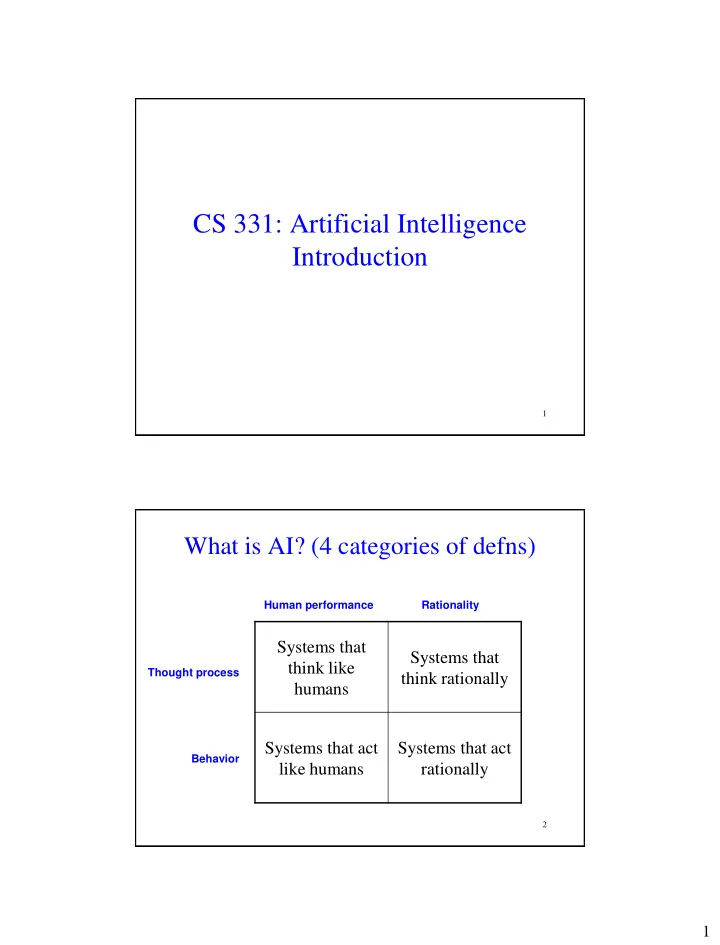

CS 331: Artificial Intelligence Introduction 1 What is AI? (4 categories of defns) Human performance Rationality Systems that Systems that think like Thought process think rationally humans Systems that act Systems that act Behavior like humans rationally 2 1
Acting like humans (Turing Test) AI Computer Can a human interrogator, after posing some written questions, tell if the responses come from a human being or a computer? Requirements for computer: natural language processing, knowledge representation, automated reasoning, machine learning, vision and robotics (the last two are for the “total Turing Test”) 3 Problems with the Turing Test • Not reproducible • Can’t be analyzed mathematically • Tends to focus on human-like errors, linguistic tricks, etc. • Does not produce useful computer programs AI researchers believe it’s more important to study the underlying principles of intelligence than duplicating how humans act 4 2
Thinking Humanly (Cognitive Modeling) • Models of the internal workings of the human mind • Validation: – Compare models with actual behavior of human subjects (cognitive science) – Compare models with neurological activity in the brain (cognitive neuroscience) • AI is now distinct from both cognitive science and cognitive neuroscience 5 Thinking rationally (Laws of Thought) Facts and rules Theorem Prover in formal logic • Rational = conclusions are provable from inputs and prior knowledge • Ensure all actions by a computer are justifiable (i.e. “rational”) Problems: • Hard to represent informal knowledge formally, especially when not 100% certain • Computationally expensive 6 3
Acting Rationally (Rational Agents) • “Agent”: something that acts • “Rational” means more than just logically justified. It also means “doing the right thing” • “Rational agent”: an agent that acts to achieve the best outcome given its resources 7 Rational Agents very few resources lots of resources limited, no thought Careful, deliberate approximate “reflexes” reasoning reasoning • Adjust amount of reasoning according to available resources and importance of the result • This is one thing that makes AI hard 8 4
AI Timeline 1943-1956 The gestation of AI 1956 The birth of AI 1952-1969 Early enthusiasm, great expectations 1966-1973 A dose of reality 1969-1979 Knowledge-based systems 1980-present AI becomes a successful industry 1986-present The return of neural networks 1987-present AI adopts the scientific method 1995-present The emergence of intelligent agents 2001 Big Data 9 AI Today • Deep Blue: first computer program to defeat the world champion in chess (1996) • AlphaGo: master-level performance at Go (2016) • NavLab: minivan drove itself across the US on its own 98% of the time (1995) • Google’s self -driving cars • Proverb: crossword puzzle solver (1998) 10 5
Other AI applications in the real world • Credit card fraud detection • Medical diagnosis programs • Computer-assisted surgery • Search engines • Personalized news sites • Collaborative filtering • Spam filtering • Disease outbreak detection • Opponents in video games 11 Surprises in AI Research • Tasks difficult for humans have turned out to be “easy” – Chess – Checkers, Othello, Backgammon – Logistics planning – Airline scheduling – Fraud detection – Sorting mail – Proving theorems – Crossword puzzles 12 6
Surprises in AI Research • Tasks easy for humans have turned out to be hard. – Speech recognition – Face recognition – Composing music/art – Autonomous navigation – Motor activities (walking) – Language understanding – Common sense reasoning (example: how many legs does a fish have?) 13 AI Courses at OSU 1. CS331: Introduction to AI (Spring quarter) • Search • Games • Knowledge Representation • Bayesian Networks 2. CS434: Machine Learning and Data Mining (Spring quarter) • Supervised Learning • Unsupervised Learning • Reinforcement Learning 14 7
1. Search 8-puzzle: Beginning with the start state, slide tiles horizontally or vertically until you get to the goal state. 15 We will discuss: 1. Search Uninformed search Informed search 7 2 4 Local search 5 6 8 3 1 7 4 7 2 4 7 2 4 7 2 4 5 2 6 5 6 5 3 6 5 6 8 3 1 8 3 1 8 3 1 8 1 7 4 7 4 7 2 7 2 4 7 2 4 7 2 4 2 4 7 2 4 5 2 6 5 2 6 5 6 4 5 6 1 5 3 6 5 3 6 7 5 6 8 5 6 8 3 1 3 1 8 3 1 8 3 1 8 3 1 8 3 8 1 8 1 8
2. Games (Fully observable) • How do you create a program to play tic-tac- toe intelligently? • What about chess? 17 3. Knowledge Representation Knowledge Base From this knowledge base, Everyone from Wisconsin is a can we derive the Packer fan All Packer fans like cheese following? Everyone from Wisconsin is • Your professor is a evil Packer fan Your professor is from Wisconsin • You will have a difficult Evil professors have difficult midterm midterms • Your professor does not like cheese 18 9
4. Bayesian Networks Example: Learning to classify emails as spam or not spam P(Spam) = 0.88 P(Spam) = 0.28 Private And Confidential Professor Hutchinson, Dear Friend, I tried to hand in homework 1 electronically but the handin script was broken. I’ve It is with heart of hope that I write to seek your attached my homework in this email… help in the context below. I am Mrs. Jumai Asfatu Abacha, the second wife of the former Nigeria head of state who died on the 8th of June, 1998. Having gotten your address through the internet, I have no doubt on your goodwill to assist us in receiving into your custody (For Safety) the sum of Forty-Eight Million, Five Hundred Thousand United States Dollars (US$48.5M) willed and deposited in my favour by my Late husband… 10
Recommend
More recommend